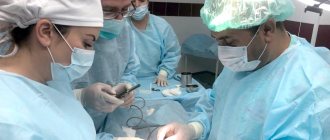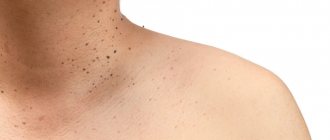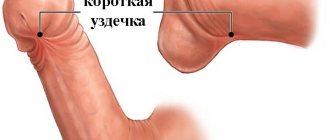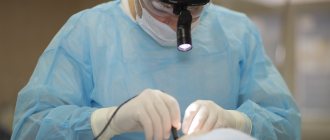Male circumcision (circumcision) is a minimally invasive surgical procedure to remove the foreskin of the penis, leaving the glans either partially covered by skin or completely exposed.
Such surgery is performed for several reasons:
- for medical reasons for a number of pathological conditions that require mandatory removal of the foreskin (phimosis, congenital anomalies of the penis, precancerous conditions);
- to prevent premature ejaculation and prolong sexual intercourse (in some cases, after removing the foreskin, the head of the penis becomes less sensitive, which allows sexual intercourse to last longer);
- based on religious considerations (Jews and Muslims) or to indicate nationality;
- for hygienic purposes.
You can find out how much it costs to circumcise the foreskin of an adult man in Moscow below. Specialists from the Federal Scientific and Clinical Center of the Federal Medical and Biological Agency of Russia guarantee a painless procedure and obtain the desired result through the use of the latest technologies and modern surgical practices.
In what cases is circumcision necessary?
Among the main medical indications for circumcision of the foreskin, experts identify:
- phimosis, which is accompanied by the inability to expose the head due to thickening or narrowing of the foreskin (the ailment can be a congenital defect or acquired);
- paraphimosis or pinching of the glans penis by a pathologically narrowed foreskin;
- recurrent inflammation of the head and foreskin (balanoposthitis), associated with poor genital hygiene, infection of soft tissues, etc.;
- multiple condylomatous growths around the head;
- precancerous conditions of the mucous membranes with a high risk of oncological transformation.
Circumcision in Moscow can be performed not only for medical reasons. The reason for its implementation may be hygienic and aesthetic purposes. The fact is that the foreskin is a place where infectious agents, moisture, dead cells and sebaceous gland secretions accumulate. It is these conditions that provide an ideal environment for the development of an inflammatory process that can disrupt sexual and urinary function. Male circumcision is one of the effective ways to prevent sexually transmitted infections.
Frenum of the foreskin
In the nth percent of men at birth, and in some subsequently through injury, the frenulum of the foreskin becomes short and not prone to stretching. Blows, injuries and active sexual intercourse can tear the frenulum. Today in the world there is only one method of treating frenulum pathology, namely surgery.
As a result of surgical intervention, either the frenulum is completely removed, or a so-called frenulotomy is performed, that is, plastic surgery of a shortened frenulum, which can be lengthened.
Surgical intervention to remove the frenulum is performed by transversely dissecting the frenulum, after which it is sutured longitudinally. In another case, the frenulum is completely removed. This operation can prevent rupture of the frenulum of the foreskin in the future. Hospitalization is not required for the operation. Healing occurs within ten to fourteen days, and sex is also prohibited during this recovery period. This procedure is carried out using laser technology, depending on the indications.
Duration
The operation itself lasts about thirty minutes under local anesthesia. The technique itself consists in making an incision across the genital organ, then suturing it in the longitudinal direction. This procedure makes it possible to eliminate excessive tension on the foreskin and will turn your frenulum into an almost invisible seam, which will turn into a natural “suture” at the bottom of the genital organ.
Complications
This operation also has complications, but they are very rare. Most complications arise from infection introduced during the operation in the form of simple bleeding.
And, nevertheless, it is necessary to take into account that in the place where the foreskin is located, there are no large vessels, which is why all bleeding is not life-threatening and can disappear at home.
In order to exclude the possibility of infection, doctors will prescribe you various types of antibiotic-based creams; they are advised to use them for three to seven days.
Inspection
In general, examination by a doctor is carried out on the second day after the operation itself, and after seven days. In general, the operation itself is not very complicated, and quite painless, and the recovery period can pass very quickly and without any complications. This operation can also be performed using a laser. The advantages of this method are that the use of laser technology minimizes the risk of introducing various infectious diseases. The rehabilitation period in this case is reduced by half. But there is an opinion in the world that removing the frenulum using a laser is not a very effective procedure, because the anatomical structure of the genital organ implies its constant movement, changes in its stretch and size, which is very often considered the cause of suture divergence. But only the patient can choose which method is better - classic or laser, everything goes according to the wishes of the patient, as well as medical indications. Also, an important point is that the urologist, before the operation itself, is obliged to prescribe examinations and tests, which include consultations with a therapist , an anesthesiologist, blood tests, in some cases according to the testimony of other specialists, and also an electrocardiogram. If all the necessary tests are present, the operation can be performed on the day of treatment. After removal of the frenulum of the foreskin, the patient has the opportunity to immediately go home. The next day he must come for an examination, or remain in the hospital for observation. Basically, the method of performing the operation does not depend on when you can begin to be sexually active again. Both in the classical and laser methods, sex is allowed after fourteen days from the end of the operation. We also advise you to avoid physical activity. In order to avoid complications and also speed up healing, we recommend:/p>
- abstain from sexual intercourse until the end of the recovery period (fourteen days);
- treat the healing area only with the medications prescribed by your doctor;
- Follow absolutely all the doctor's instructions.
Circumcision of the foreskin for phimosis
Most often, excision of the foreskin in representatives of the stronger sex is carried out specifically for phimosis. This diagnosis refers to a narrowing of the foreskin, in which the head of the penis is difficult to expose during erection. Surgical intervention eliminates the pinching ring of the foreskin that forms during phimosis.
The operation to remove phimosis in men is carried out in our medical center, the price of the procedure is as affordable as possible for a wide range of patients and fully corresponds to the declared result. You can find out the cost of treatment and surgery for phimosis, ask questions and set a date for surgery in consultation with a specialist.
Types of circumcision
Already at the first visit to the surgeon, the patient has the opportunity to learn about the options for performing surgery to remove the foreskin. There are several types of surgery currently being performed:
- low circumcision, when the inner edge of the tissue is completely excised with a suture placed along the edge of the coronary groove;
- medium circumcision, after which part of the foreskin is preserved, and the seam is located 1.5 cm above the base of the penis;
- a high type of circumcision, in which the surgeon leaves the inner layer of the foreskin and makes a suture no closer than 2 cm from the base of the penis.
Risks and complications associated with circumcision
Although complications due to circumcision are rare, they can occur for a number of reasons. Here are some of the possible complications:
- pain;
- bleeding from the wound;
- bruising or swelling (swelling) of the penis – disappears spontaneously after a few days;
- infection;
- cutting off too much or too little of the foreskin of the penis – this may require another surgical procedure;
- every erection in the recovery phase is painful;
- possible change in sensations during sexual intercourse;
- irritation of the penis.
If the child has problems with urination 6-8 hours after circumcision, fever, redness of the skin of the head of the penis, progressing after 3-5 days, bleeding, then it is necessary to consult with your doctor.
Circumcision of children also raises ethical issues. Opponents of circumcision emphasize that it is an important intimate decision in which the child cannot participate.
Minimum operation type
In this type of circumcision, a small portion of the foreskin is removed. Such an operation is performed primarily on those patients who resort to the procedure for religious reasons, but do not want to make significant changes to the physiology and appearance of the genital organ.
Partial excision
As a result of such surgical correction, the head of the penis remains fragmentarily covered with soft tissue, and the urethral opening is free.
Non-tight excision
In this case, the foreskin is removed in large quantities, while the coronary groove remains covered with a fold of skin.
Moderate type
The surgeon cuts the skin and completely exposes the head of the penis, which does not hide even when exposed to low temperatures. The appearance of the penis changes significantly.
Tight excision
The foreskin is completely removed, after which the skin becomes very stretched during an erection. Tight circumcision is done very rarely. It is prescribed for strict medical reasons or at the request of the patient himself.
What conclusions are drawn based on scientific assessments?
Based on the results of many studies, the following has been established.
In circumcised men, penile cancer develops much less often, several times, compared to those who have a natural foreskin.
Similar statistics are available for women, if the sexual partner is circumcised - cervical cancer is up to seven times less common in them.
Genital infections also develop less frequently in those who have undergone circumcision.
According to sex therapists, a circumcised penis looks more aesthetically pleasing and attractive - a neat head of the penis is perceived better than unaesthetic and wrinkled skin.
More hygienic, without a doubt, is an open head, because the possibility of accumulation of natural secretions and dirt is reduced to almost zero. This area no longer creates an environment conducive to the proliferation of any pathogenic microflora. As a result, the risk of developing inflammatory diseases - local and generalized inflammation and erosions - is greatly reduced.
A circumcised head leaves no chance of getting phimosis and balanoposthitis.
Matar Asaad Akhmadovich
Head of the center, professor, pediatric surgeon, urologist-andrologist
The main principle of our center is high professionalism, dedication to their profession, human participation and mutual understanding between specialists, young patients and their parents!
Go to doctor's page
How is foreskin circumcision performed?
Circumcision is a minimally invasive surgical procedure that does not require a long hospital stay or hospitalization. It is performed under local anesthesia, but sometimes the doctor may decide whether to use general anesthesia.
During surgical circumcision, a circular excision of the foreskin is performed, after which the wound is sutured with threads that dissolve on their own. The volume of tissue removal and the location of the sutures are discussed with the patient before the procedure.
Why do we recommend circumcision surgery with us?
The main reasons why an adult man should have surgery to circumcise the foreskin at the Federal Scientific and Clinical Center of the Federal Medical and Biological Agency:
- competence and high qualifications of medical staff necessary to carry out high-quality surgical intervention without consequences;
- the most reasonable price;
- complete confidentiality of patient information;
- predictability of results, when a man can count on exactly the effect that was agreed upon with the surgeon before the procedure;
- the use of modern painkillers, which makes the procedure easy and painless.
Preparation for circumcision
After the patient has paid the cost of male circumcision surgery in Moscow, he needs to undergo special preparation for surgery, including:
- make an appointment with a doctor who must examine the patient, decide on the type of circumcision and the extent of the operation;
- stop drinking alcoholic beverages and smoking several days before the procedure;
- pass mandatory tests (general and biochemical blood and urine tests, urethral culture for microflora, other tests prescribed by a specialist);
- adhere to the rules of genital hygiene;
- stop taking blood thinning medications for a while.
In the vast majority of clinical cases, the operation to circumcise the foreskin is performed under local anesthesia; immediately before the procedure, the man is allowed a light breakfast. If the surgeon decides to use general anesthesia, the patient is prohibited from eating from the second half of the day preceding the date of surgery.
Behavior after surgical treatment of phimosis
When the operation is completed, the patient is transferred to a ward, where he needs to rest for a couple of hours and recover. As a rule, if the patient is feeling well, the patient is sent home almost immediately.
The postoperative period lasts 7-10 days. During this period, the patient may feel discomfort and mild pain, but he should not resort to using painkillers. If the pain intensifies, the doctor may recommend that the patient take non-steroidal anti-inflammatory drugs.
It is important to change dressings every two days during the postoperative period. The patient needs to ensure that the dressings always remain clean and that urine does not come into contact with them, as this can lead to inflammatory processes. To keep the dressing dry, you can use a condom while bathing. The postoperative period ends with the removal of sutures. It is recommended to wear thick underwear for some time after the stitches are removed.
Rehabilitation after circumcision
The man is allowed to leave the clinic 2 hours after the procedure to remove the foreskin. When excision of soft tissues in the classical way, for several days after surgery, the patient may experience the following complaints:
- development of swelling with redness at the surgical site;
- the appearance of nagging pain in the area of the postoperative wound;
- discomfort during urination and when the genital organ comes into contact with underwear.
All these unpleasant consequences go away on their own after a few days. Most often, they are mild, so most patients continue to do their usual activities the next day.
Dehiscence of the sutures placed by the surgeon is the most common complication. Moreover, in most clinical cases it occurs due to the fault of the patient himself. To ensure that the rehabilitation period passes as quickly and efficiently as possible, experts advise following several recommendations:
- in order to prevent the development of the inflammatory process, doctors prescribe patients a preventive course of antibiotic therapy and drugs with anti-inflammatory effects, and in case of persistent pain, prescribe analgesics;
- It is prohibited to visit the pool, take hot baths, play sports, lift weights, or take a steam bath or sauna for several weeks;
- You must avoid sexual intercourse for 2 weeks.
Post-operative care: secrets of quick recovery
In the first hours after the circumcision operation and the weakening of the anesthesia, the patient may feel pain, which is relieved with the help of anesthetics; the discomfort completely disappears after 1-2 days.
- Postoperative sutures are processed daily. In the first 3 days, the sterile dressing is changed 3 times a day.
- Then the procedure can be performed once a day. The bandage is soaked in hydrogen peroxide or a decoction of chamomile, this allows you to remove it without pain and without injuring the wound.
- The dressings are changed for 10 days, then the suture area remains open. To disinfect, it is treated with hydrogen peroxide or chlorhexidine. There is no need to remove sutures; the threads dissolve on their own.
In some cases, patients experience bloody discharge. Treating the seams with Levomekol, a solution of furatsilin or potassium permanganate will help remove them. Taking Methyluracil will help speed up the healing of wounds. If bleeding does not stop, urgent consultation with a urologist is necessary. It is important to monitor your drinking regime. You should not drink too much liquid; instead of diuretic drinks such as coffee and black tea, herbal infusions, homemade fruit drinks and pure still water are recommended.
The recovery period lasts about 2 weeks. During this time, the sutures heal completely, swelling subsides, and the penis takes on a normal appearance. You must abstain from sexual intercourse and masturbation for another 2 weeks.
In the next few months, it is better to use barrier contraceptives (condoms), which reduce the risk of infection or microtrauma. When swelling occurs, baths with table salt are recommended (1 teaspoon per glass of warm water). Circumcision in adult men is an operation that is performed for medical, hygienic and other reasons. There will be no complications, and the recovery period will not be prolonged and the patient will quickly return to normal life, subject to hygiene rules. Thanks to the article, you learned how circumcision is performed, with the patient being admitted to a hospital or on an outpatient basis, and you got acquainted with the photo after the circumcision operation. We hope this information was useful to you!







